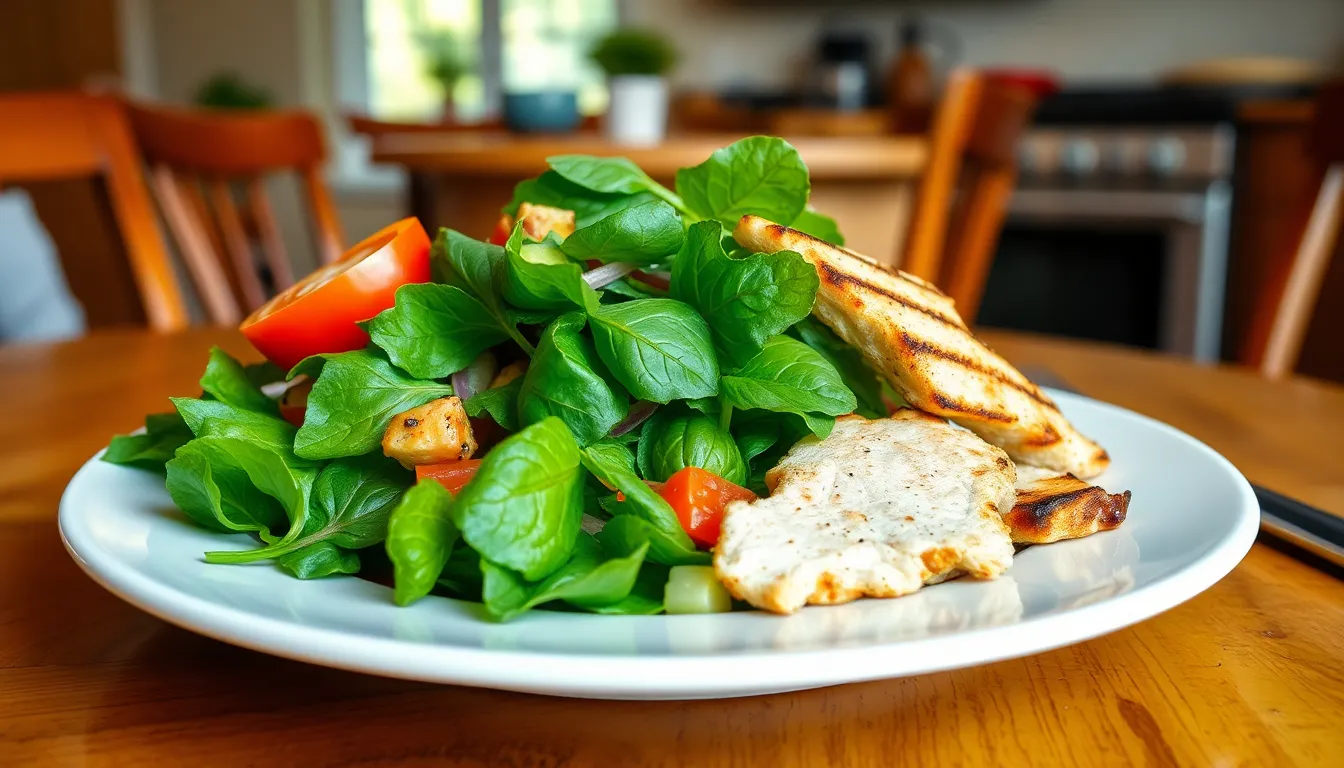Table of Contents
ToggleIn a world where calorie counting feels like a full-time job, low-calorie recipes swoop in like a superhero ready to save the day. Who says eating healthy has to be boring? With a sprinkle of creativity and a dash of humor, whipping up delicious meals that won’t break the calorie bank is easier than ever.
What Are Low-Calorie Recipes?
Low-calorie recipes are meals designed to be lower in calories while still providing nutrition and flavor. These dishes focus on healthy ingredients that satisfy hunger without excessive calorie intake. Fresh vegetables, lean proteins, and whole grains often feature prominently in these recipes.
Eating low-calorie meals promotes weight management and overall health. Incorporating fruits and vegetables brings essential vitamins and minerals, enhancing the dishes’ nutritional value. Many low-calorie recipes utilize cooking techniques that minimize added fats, such as grilling, steaming, or baking.
Flavor plays an important role in low-calorie cooking. Herbs and spices substitute for calorie-dense sauces or dressings, allowing for taste without excess calories. This approach means enjoying meals that feel indulgent while fitting within a calorie-conscious framework.
Portion control also matters in low-calorie recipes. Striking a balance between the quantity of food and its caloric content ensures meals satisfy cravings without leading to overeating. Mindful portioning encourages enjoyment of each dish, contributing to a positive dining experience.
Low-calorie recipes vary to cater to different dietary preferences, from vegetarian to low-carb. Examples include zucchini noodles paired with marinara sauce or grilled chicken served with quinoa and roasted vegetables. These diverse options make it easy to find something for everyone to enjoy while pursuing a healthier lifestyle.
Benefits of Low-Calorie Recipes

Low-calorie recipes offer myriad benefits for individuals seeking to maintain a healthy lifestyle. These meals support various health goals while delivering nutrient-rich options.
Weight Management
Low-calorie recipes assist in weight management by providing balanced nutrition with reduced caloric intake. Incorporating these dishes helps individuals consume fewer calories without sacrificing satisfaction. Many recipes focus on volume, allowing for larger portions that contribute to fullness. Lean proteins and high-fiber ingredients play a crucial role in suppressing hunger. Evidently, regular consumption of low-calorie meals leads to better weight control and decreased body fat percentage. Research shows that participants in low-calorie diets experienced significant weight loss over time.
Improved Health
Consuming low-calorie recipes can improve overall health due to their emphasis on whole foods and essential nutrients. Meals rich in fresh vegetables and lean proteins enhance micronutrient intake, supporting immune function and overall well-being. Low-calorie diets often result in lower cholesterol and blood pressure levels. Studies indicate that individuals adhering to these meal plans report better metabolic profiles and reduced risks for chronic diseases. Emphasizing healthy cooking methods also contributes to maintaining physical wellness while enjoying flavorful dishes. Overall, these recipes foster healthy habits that promote long-term vitality.
Popular Low-Calorie Ingredients
Low-calorie ingredients make healthy cooking approachable and enjoyable. Incorporating these foods can elevate meals while keeping calories in check.
Fruits and Vegetables
Fruits and vegetables serve as foundational components of low-calorie recipes. Leafy greens like spinach and kale provide essential vitamins with minimal calories. Bell peppers and zucchini add sweetness and crunch without excess calories. Berries, such as strawberries and blueberries, pack antioxidants and fiber into delicious snacks or toppings. Citrus fruits like lemons and limes enhance flavors while contributing very few calories. Incorporating a variety of colors ensures a broad spectrum of nutrients and keeps meals vibrant.
Lean Proteins
Lean proteins form another essential part of low-calorie cooking. Chicken breast, turkey, and fish supply high protein levels with low fat content. Tofu offers a plant-based option rich in protein and other nutrients. Legumes like lentils and chickpeas contribute fiber and sustain energy without high calories. Eggs provide versatility for breakfast or snacks, delivering quality protein with fewer calories than many other sources. Incorporating these proteins into meals satisfies hunger and supports muscle maintenance while keeping overall calorie counts down.
Easy Low-Calorie Recipes
Creating satisfying meals doesn’t require a high-calorie count. Low-calorie recipes offer delicious flavors while keeping caloric intake in check.
Breakfast Ideas
Start the day with a spinach and mushroom omelet. Packed with protein and fiber, it delivers essential nutrients. Greek yogurt topped with mixed berries serves as another great option. This combination provides antioxidants while keeping calories low. Overnight oats made with almond milk, chia seeds, and a sweetener like honey or maple syrup can also be delicious. Each serving can be customized, adding nuts or fruits for extra texture and flavor.
Lunch Options
Consider a quinoa salad featuring chickpeas, cucumbers, and tomatoes. This dish brims with protein and fiber while remaining light. A whole-grain wrap filled with turkey, lettuce, and hummus combines convenience with nutrition. Another option includes a vegetable stir-fry using zucchini, bell peppers, and carrots. Serve it over cauliflower rice for a low-carb meal offering bright colors and fresh tastes.
Dinner Delights
Baked salmon seasoned with herbs provides heart-healthy omega-3 fatty acids. Pair this with steamed broccoli for a nutritious side. A lean turkey chili, made with kidney beans and diced tomatoes, stands out for its protein content. Lettuce wraps filled with ground chicken, bell peppers, and spices offer a fun, low-calorie alternative. Each dish combines ease of preparation with flavorful ingredients, ensuring satisfying dinner experiences.
Tips for Making Low-Calorie Recipes
Making low-calorie recipes involves several techniques that enhance flavor while keeping calories in check. Focusing on ingredient substitutions can dramatically affect the overall caloric content of dishes.
Substitutions
Using lower-calorie alternatives boosts flavor without extra calories. For example, Greek yogurt can replace sour cream, adding creaminess and protein. Cauliflower can serve as a base for pizza crust instead of traditional dough. Opting for spaghetti squash instead of pasta reduces carbohydrates while providing texture. Everyone can swap oils for cooking sprays or vegetable broths, minimizing fat content significantly. Certain spices and herbs can amplify taste, reducing the need for high-calorie sauces and dressings. These simple changes empower cooks to create satisfying meals with fewer calories.
Portion Control
Managing portion sizes significantly influences calorie intake. Plating meals on smaller dishes often helps control serving sizes. Eating slowly allows individuals to recognize when they’re full, preventing overeating. Utilizing measuring cups or a food scale to gauge serving sizes adds accuracy to meal preparations. Filling half of the plate with vegetables increases volume while minimizing calories. Creating a balanced plate of proteins, grains, and veggies satisfies hunger and promotes dietary adherence. Adopting these portion control strategies leads to satisfying meals that keep calorie counts low.
Embracing low-calorie recipes can transform the way one approaches healthy eating. By focusing on nutritious ingredients and clever cooking techniques, anyone can enjoy flavorful meals without the guilt of excess calories. These recipes not only support weight management but also contribute to overall well-being.
With a wealth of options available, it’s easy to find meals that fit various dietary preferences. The combination of portion control and wholesome ingredients ensures that satisfaction doesn’t have to be sacrificed. Whether it’s a hearty breakfast or a light dinner, low-calorie recipes offer a delightful way to nourish the body while enjoying every bite.





